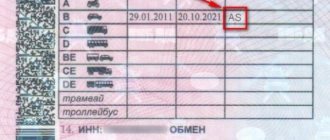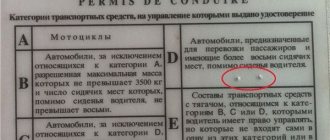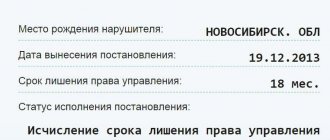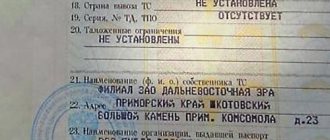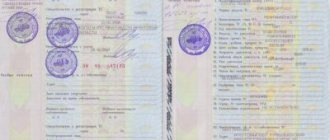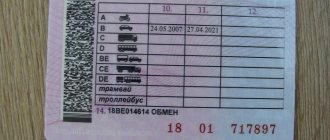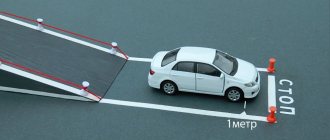03.01.2021
no comments
3256
You can often find that on the back of a driver’s license there is a GCL mark or the inscription “Glasses/lenses are required” (for old-style documents). As expected, this obliges the driver to use vision correction devices when driving a vehicle, since this has been determined by a medical examination. If this requirement is not met, the traffic police inspector has the right to draw up a report on the administrative violation and impose a large fine. Read about the legal intricacies of driving with a GCL to avoid trouble on the road.
What does the GCL mark on a driver's license mean?
Some citizens may have the inscription GCL on their vehicle driving license.
On the new type of ID cards it is located on the back side, opposite the one on which there is a photograph of the owner, at the very bottom. This is a field for special marks, the so-called fourteenth point. Next, we will consider what it means to have the GCL inscription on your license, the driver’s responsibilities, and sanctions for violation. The GCL decoding on a driver's license means glass contact lens - “glasses or contact lenses.” The inscription means that the citizen indicated in the document must use the listed vision correction devices when driving.
When and to whom the GCL mark is put on the license
The registration and issuance of a temporary residence permit for the first time or when replacing it upon expiration of its validity period is preceded by a medical examination. In addition to other health indicators, vision must be checked. During testing, you need to read the rows of a special table from a certain distance. The test results are recorded in a medical certificate of the established form. If visual acuity is below standard, the need to use glasses or lenses is noted.
This is the basis for affixing the letters GCL to the license.
Note. These marks are not placed on the license to drive special equipment, for example, a tractor driver.
ABOUT
The GCL mark is only applied when the driver is not allowed to drive without vision correction equipment. If there is a slight deterioration in visual acuity due to the current traffic regulations, no restrictions are imposed on drivers. It’s a completely different matter when restrictions are introduced for medical reasons. There is a threshold at which it becomes unsafe to drive a car without glasses, so a note is added to the license that stipulates the mandatory use of glasses or lenses when driving a car.
The mark of such a sample can be seen in the rights of the new sample. Its literal translation means “glasses/contact lenses.” This sign obliges the driver to use vision correction devices, otherwise he will violate traffic rules.
To open the B-category when drawing up a driver's document, one eye (the dominant) must see at least 0.6 units, and the other at least 0.2 units. To open the C-category, these indicators must be at a level, respectively, greater than 0.8 units and greater than 0.4 units. If a person does not have a clearly defined dominant eye, then the acceptable norm is 0.7 units.
Where is the mark on the new model of the driver's license?
The front and back sides of the ID are divided into fields. Each of them contains certain information about their owner:
- Surname
- First and middle name
- Date and place of birth
- Validity period of the license, etc.
There are a total of 9 fields on the front side. The last of these is the permitted categories of driving vehicles. The fields are numbered, numbers are in front of each inscription.
On the reverse side there is a table indicating vehicle categories and opening dates (10), expiration dates (11) and control restrictions (12).
Column 13 is occupied by a barcode.
Below the table is a number. This is column 14 in the driver’s license, reserved for special marks. It contains the Latin letters GCL, indicating vision problems and a requirement to wear glasses or lenses when driving a car or motorcycle.
Driver's rights functionality
Confirmation of the right to drive - a driver's license - is an integral part of the set of documents confirming the right to drive a car. Due to its compact size, the document is very convenient to use. It contains a large amount of transmitted information. In addition to indicating the category of vehicle to which the driver is admitted, all personal data of the owner is written there.
A license can serve to prove identity, just like a passport.
The format of the document confirming the driver’s right to drive was approved by Order of the Ministry of Internal Affairs of Russia No. 365 in 2009, which deals with the introduction of the certificate into force. Later, adjustments were introduced, according to which in 2021 (starting from April 4), abbreviations that are unusual for drivers began to appear, written in Latin letters in the updated licenses issued.
The new type of certificate retains 14 columns, just like the old one, 9 of which are on the front side.
They state:
- personal data of the driver, filled in from the passport (columns 1–3);
- In No. 4 - points a), b), c) - information about the date of issue of the document, validity period and the issuing authority;
- No. 5 – identification data (series and number), identical to those indicated on the other (reverse) side;
- columns 6–8 – photo of the owner, personal signature and place of residence, registration;
- No. 9 – categories of vehicles permitted for driving.
The reverse side contains the following columns (10–14), arranged in table form (except for columns 13, 14):
- columns 10–11 – the validity period of the certificate will be entered opposite the open category;
- No. 12 is used specifically for making special marks associated with an open category of rights;
- the barcode located to the left of the table is considered column 13;
- No. 14 is reserved for indicating designations associated with all categories permitted for driving, and information about the total length of experience is also entered there.
First, in 2014, the State Traffic Safety Inspectorate introduced pictograms of new subcategories (although new documents began to be issued in 2021, the changes were approved in 2014). This was done to comply with the established clauses of the Vienna Convention - an international treaty on bringing traffic rules to a common denominator.
Now the processing of driver's documents is as close as possible to Western standards. With an updated certificate, you can travel on most European highways without problems of mutual understanding with traffic police officers. Special categories have been introduced - B1 and E. The first (B1) designates permission to drive a vehicle with a motorcycle-type steering wheel, mainly tricycles and ATVs.
The second (E) can be added to the previously entered B, C, D in different variations:
- by adding the E value to category B, a corresponding clarification appears - the driver can cope with the control of a vehicle with a trailer, the total weight of which is less than or equal to 3.5 tons;
- the appearance of E in open category C means that it is allowed to drive a vehicle with a large trailer with more than 2 axles;
- the designation E added to D serves as a permit for driving an articulated passenger vehicle (for example, Ikarus).
The introduction of unusual abbreviations, according to which in April 2016 they began to issue updated licenses, affected only two columns of the certificate:
- No. 12 – used to set restrictions associated with a particular category of transport;
- No. 14 – the total driving experience (since the date of issue of the first license) and clarifications for all open categories are entered (as a rule, these are notes on the state of health and special instructions related to this).
New marks began to appear in these columns, the most frequent being those indicated above (AS and GCL).
Driving a vehicle in violation of the specified special symbols or open categories is severely punished as a serious violation of traffic rules.
For violating special marks when driving a vehicle, a fine is imposed in the same amount as for driving without a license - from 5 to 15 thousand rubles.
The encoded meaning of the entered abbreviations is worth knowing and remembering, because ignorance of the law does not exempt you from obligations. For such an offense, you face administrative liability under Article 12.7 Part 1 of the Code of Administrative Offenses of the Russian Federation for driving a vehicle without documents confirming permission to drive.
What other marks are put according to medical restrictions?
In addition to visual impairments, drivers may have other health problems that result in restrictions on driving. There are special designations for them, indicated in paragraph 14 of the military license:
- MC (Manual Control Only) The car must be equipped with a system that allows you to drive it with your hands without using your feet.
- AT (Automatic Transmission) – the driver can only drive vehicles with an automatic transmission
- APS (acoustic parking system only - only automatic parking system)
- HA/CF (must wear hearing aid/communication aid) – a hearing aid is required when driving.
These are the most common designations. Sometimes people ask what ML means in rights. This is a direct prohibition of driving category M vehicles such as scooters, mopeds, etc. Or AS - permission to drive vehicles with a traditional steering wheel.
In addition to medical indications, paragraph 14 of the license may indicate the date of receipt of the driver's license. This is usually written by novice drivers.
Special license marks: what do they mean? [list]
Details Category: Articles Published 09.19.2019
Today in our material is a review of the special marks that are placed on the back of the new driver’s license. We will tell you what they mean further.
Mark AS
The AS mark is only for those drivers who have open category B, but not category A.
AS stands for “automotive steering”, which translates as an automobile type of steering. This mark is placed opposite subcategory B1 in the new driver’s license.
Subcategory B1 with the mark AS means that the driver is allowed to drive motorcycles and tricycles with car-type control. In this case, the automobile type of control means the presence of a steering wheel (namely, a wheel, in the literal sense) and an automobile seat (that is, not in the saddle, but in a chair, like a car).
Accordingly, for those drivers who have categories both A and B, this mark is not placed.
Mark MS
The MS mark is only for those drivers who have open category A, but not category B.
MS stands for “motorcycle steering”, which translates as a motorcycle type of steering. This mark is placed opposite subcategory B1 in the new driver’s license if the driver does not have category B.
Subcategory B1 with the MS mark means that the driver is allowed to drive motorcycles and tricycles with motorcycle-type control and seating. In this case, a motorcycle type of control means the absence of a car steering wheel, and a motorcycle seat means the presence of a motorcycle saddle rather than a car seat.
Accordingly, for those drivers who have categories both A and B, this mark is not placed.
GCL mark
The GCL mark is only available for drivers with poor vision. GCL stands for “glasses or contact lenses,” which translates as “glasses or contact lenses.” In other words, the GCL mark means that the driver, for medical reasons, must drive a car with glasses or contact lenses.
For violation of this requirement, theoretically, you can receive a fine as for driving a car without a license of the appropriate category. However, in fact, it is difficult to punish this violation. Even if the driver drives without glasses, he can always say that he is wearing contact lenses. And the traffic inspector is unlikely to be able to check the presence of contact lenses - he has no right to force them to be removed and shown.
Mark ML
To begin with, let us recall what category M is in the new rights. It refers to mopeds and scooters. According to the latest amendments, to drive mopeds and scooters you need to obtain a license of category M. However, if a driver who has graduated from a driving school already has a license of any other category, then he is automatically allowed to drive vehicles of category M.
But if the driver has a license, for example, category A or B, but for medical reasons he cannot drive mopeds and scooters, then an additional MS mark is placed on the license. That is, the MS mark indicates a ban on driving category M vehicles.
AT mark
The AT mark on the license means that its owner has the right to drive cars only with an automatic transmission. The fact is that now in driving schools there are separate courses where they teach driving only with an automatic transmission. After completing these courses and passing the exam, the driver receives a license with the AT mark. That is, he is prohibited from driving a manual car with such a license.
But drivers who were trained with a manual transmission receive a license without an additional mark: they have the right to drive both a manual transmission and an automatic transmission.
In addition, the AT mark is placed on the license of drivers who, for medical reasons, cannot drive a car with a manual transmission: no right arm, left leg, etc.
Mark MC
The MC mark indicates that the driver can only drive cars with manual controls (hand levers are installed instead of pedals). Typically, such cars are driven by people with disabilities who have problems with the musculoskeletal system. By decision of the medical commission, they are issued a license with the MC mark. The MC mark prohibits driving normal vehicles (without manual control).
APS mark
The APS mark means that the driver can drive the car only if there is an acoustic parking system, that is, parking sensors.
In what cases is the APS mark placed on the license? Most often this is due to medical contraindications. For example, if the driver is missing one eye or has other vision problems that do not allow him to correctly judge the distance. In this case, with such a mark it is prohibited to drive cars without parking sensors. However, the regulations do not specify anywhere whether parking sensors should only be in the rear, or also in the front of the car.
HA/CF mark
The HA/CF mark means that the driver can drive the vehicle only if he wears a hearing aid or other hearing correction device. A similar mark is placed on drivers’ licenses based on the results of a medical commission if hearing problems are confirmed. With the HA/CF mark, it is prohibited to drive without a hearing aid.
Is it possible to eliminate a mark?
To obtain a license, it is necessary to present a medical certificate. There are several options when this can be done without it. In this case, the same marks will be added to the new document, including the fourteenth paragraph with GCL, that were in the old one. Therefore, to get rid of them, you need to show the ophthalmologist during a medical examination that your vision does not require correction.
Attention! The medical examination must be completed in an organization that has the appropriate license. Otherwise, the certificate will not have legal force, and it will not be possible to remove the mention of mandatory glasses or lenses. Time and money will be wasted.
With a certificate, you should contact the authorized organization REO of the State Traffic Safety Inspectorate, MFC, etc. and obtain new rights to replace the old ones without unwanted letters in special marks.
What to do if the driver has had vision correction surgery
Legally, the question of whether it is mandatory to wear glasses or contact lenses while driving a vehicle arises when documents are checked by a traffic police inspector. He cannot, is not obliged and does not have the authority to check the compliance of vision with standard indicators. In this matter, the only guide to action for him is the information from the document.
If, as a result of surgical treatment, a citizen’s vision is restored to a normal level that does not require correction, but the license remains old with the GCL mark, the inspector has the right to require the wearing of glasses. In their absence, he has the right to apply sanctions provided for by law.
To avoid such a situation, the driver must visit a licensed medical institution, undergo a medical examination, and obtain a certificate confirming normal vision. Contact the MFC, REO of the State Traffic Safety Inspectorate with it and replace the existing rights with new ones that do not contain a note in column 14.
Only after this will it be possible to drive without glasses or contact lenses.
Is it necessary to use glasses/lenses if vision is poor, but there is no note on your license?
As explained earlier, for persons controlling traffic, the legal obligation to wear glasses or lenses exists if there is a special mark on the license. Without it, even with poor vision, it is impossible to force the driver to wear glasses.
Keep in mind: the use of corrective agents is primarily necessary to ensure safe driving.
With reduced vision, you may not notice a road sign, be unable to read a warning sign, or be unable to distinguish a cyclist or pedestrian. All cases are fraught with a traffic accident with serious consequences. When examined by the traffic police or in court, visual impairment will be identified, and it is possible that the blame for the consequences will be placed on the driver. The basis for this may be clause 2.7 of the traffic rules, which prohibits driving while sick. This concept is not specified by the rules, but under certain circumstances it can be classified as reduced vision.
Conclusion. There is no need to risk your own health, property, and in the worst case, freedom and life. You should consult a doctor and put on glasses or contacts yourself, without waiting for the mandatory mark on your license to appear.
An exception can be made when visual acuity is about 0.9. At the same time, during the day everything is visible quite well, but with the onset of twilight it is worse.
How to remove the abbreviation GCL from rights
The GCL mark can be removed based on a medical report. Re-examination is resorted to after surgery to restore vision. To do this, it is not necessary to wait until the document expires. To pass a medical examination, you must contact the traffic police department with an application for a replacement driver’s license. It is better to do this immediately after laser vision correction. While the driving license is marked GCL, the driver is required to wear glasses or contact lenses. Again, it will be difficult to prove the opposite to a traffic police inspector on the road.
Conclusion
The requirement to wear glasses or contact lenses is not a way to restrict a driver’s rights, but an opportunity to reduce the occurrence of accidents on the roads. Judging by statistics, about 1,500 traffic accidents occur annually, in which drivers with impaired vision and neglecting the requirement to wear special correction devices are to blame. If, based on the results of a medical examination, the commission decided to add the GCL mark to the driving license, the driver should choose glasses or lenses. Even if in everyday life you do without special means, do not neglect them on the road. Perhaps this will save someone's life.
The SAI driving school in Yekaterinburg offers driving training. Call: 8 (343) 210-70-00 or order a call back on the website.
What are the penalties for violating marks?
There is no direct punishment in the Administrative Code for the absence of glasses or lenses, which are prescribed to be worn in column 14 of the driver’s license. However, if an inspection reveals a discrepancy, sanctions will not be avoided. In accordance with the explanations of the head of the Russian State Traffic Safety Inspectorate, the absence of glasses is equivalent to driving without a license. The same position is adhered to in court.
A discrepancy between the last name, first name, patronymic, and date of birth makes the driver’s license invalid. Driving a vehicle without a permit mark in the category column is also considered driving without a license. The absence of points in the presence of GCL letters in paragraph 14 is assessed in the same way.
According to paragraph 12.7 of the Code of Administrative Offenses, driving a vehicle without a license or without mandatory glasses is punishable by a fine of 5,000...15,000 rubles. In this case, the offender may be removed from driving, and the car or motorcycle may be sent to the impound lot.
Considering the interest of automobile inspection employees in identifying violations and carefully hidden plans for the number of protocols, it is better not to take risks and wear glasses or contacts.
Fine for driving without glasses/lenses
From the point of view of the law, if the mark is in the driving license, then the situation with a fine for driving without glasses or lenses is not clear. The Code of Administrative Violations does not contain any information about fines related to driving a car without vision correction devices. But a completely different situation develops in practice. Service employees associate this as driving a car without the right to control it; they apply Article 12.7, which provides for a fine of 5 thousand rubles. up to 15 thousand rubles.
Part 1 of Article 12.7 of the Code of Administrative Offenses of the Russian Federation “Driving a vehicle by a driver who does not have the right to drive a vehicle”
“Driving a vehicle by a driver who does not have the right to drive a vehicle (except for instructional driving) shall entail the imposition of an administrative fine in the amount of five thousand to fifteen thousand rubles.”
By the way, the collapse of the legislative framework allows you to appeal the decision of a traffic police officer to impose a fine in court. With the correct interpretation of concepts and terms, it is possible to apply the sanctions of Part 2 of Article 12.3 with a fine of 500 rubles. However, this requires additional resources and time to appeal.
Part 2 of Article 12.3 of the Code of Administrative Offenses of the Russian Federation “Driving a vehicle by a driver who does not have with him the documents provided for by the Traffic Rules”
“Driving a vehicle by a driver who does not have documents for the right to drive it, an insurance policy of compulsory insurance of civil liability of vehicle owners, with the exception of the case provided for in Part 2 of Article 12.37 of this Code, and in cases provided for by law, a waybill or product transport documents, -
entails a warning or the imposition of an administrative fine in the amount of five hundred rubles.”
Is it necessary to prove to a traffic police officer the presence of lenses?
Every duty implies the possibility of verifying its fulfillment. The necessity contained in the fourteenth paragraph of the VU is no exception. In this case, there is a note in the license about glasses, obliging the use of vision correction devices. The presence of glasses is visible and beyond doubt. An ophthalmologist can recognize the lenses. By the way, there is no need to try to undergo a medical examination in them and do not put an unwanted mark on the Permis de conduire - this is how the name of the old-style document was duplicated. The cunning man will be exposed, the lenses will be forced to be removed, and the real state of affairs will be revealed. The traffic police inspector most likely does not possess such skills; claims can be expected from him regarding violation of the requirements of paragraph 14.
Important! No legal norms stipulate the obligation of citizens to prove the presence of lenses on the road. You can simply say that he has them. In the event of a conflict, it is necessary to write about it in the protocol, and the court will support its correctness.
In order not to take the situation to the extreme, it is recommended to stock up on some document confirming the presence of lenses, at least a receipt for their payment, and carry the original or a copy with you. The traffic inspector knows the laws, that will be enough.
What about medical vision limitations in 2021?
Everything is clear here. There is an adopted Government Resolution No. 1604, which sets the limits of vision:
- In the worst visible eye, vision should be at least 0.2;
- On the best eye - not lower than 0.6.
The norm is fulfilled for both eyes at once. If at least one condition is not met, therefore, the subject cannot control the vehicle.
It is impossible to determine the quality of vision simply at the discretion of the inspector. Therefore, he cannot issue a fine either if there is a mark on the license or if it is absent. Even if he thinks that the driver sees very poorly. Only a medical examination allows you to obtain a reliable result. Until then, they have no right to issue a fine.
conclusions
- The GCL mark on your license indicates visual impairment. If it is present, the vehicle must be driven with glasses or contact lenses.
- In order to issue a license without this mark, confirmation of visual acuity compliance with the standards is required. When replacing in a new device, this inscription will be omitted.
- After corrective surgery, you must undergo a medical examination. If the outcome is favorable, a medical certificate will be issued allowing you to drive without glasses. On its basis, the rights will be replaced with “clean” ones.
- If you have poor eyesight and do not have a note on your license, you can legally drive without glasses. It is recommended not to abuse this for traffic safety.
- For driving without glasses or lenses with the GCL mark, the violator is fined 5,000...15,000 rubles and the car is detained and placed in an impound lot.
- The driver is not required to prove that he is wearing contact lenses. To avoid conflict situations, it is recommended to keep with you any document confirming their availability.
